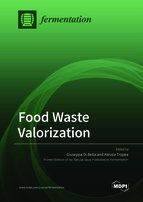Food Waste Valorization
A special issue of Fermentation (ISSN 2311-5637). This special issue belongs to the section "Industrial Fermentation".
Deadline for manuscript submissions: closed (31 August 2021) | Viewed by 69327
Special Issue Editors
Interests: food contamination; food safety; plasticizers; bisphenols; environmental pollutants
Special Issues, Collections and Topics in MDPI journals
Interests: fermentation process management; biofuel; biorefinery; value-added products
Special Issues, Collections and Topics in MDPI journals
Special Issue Information
Dear Colleagues,
During the industrial processing of agricultural or animal products, large amounts of waste are produced. These wastes, generated in large amounts throughout the seasons of the year, can be considered the most abundant renewable resources on earth.
Due to the large availability and richness in components of these raw materials, there is a great interest in their reuse, both from an economical and environmental point of view.
This economical interest is based on the fact that a high quantity of such wastes could be used as low-cost raw materials for the production of new value-added compounds, with a further production cost reduction. The environmental concern is derived from their composition, especially the agro-industrial wastes that can contain potentially toxic compounds, which may cause deterioration of the environment when uncontrolled wastes are either burned, left on the soil to decay naturally or buried underground. Moreover, these materials exhibit both high biochemical oxygen demand (BOD) and chemical oxygen demand (COD) values, and give rise to serious pollution problems if not properly disposed of.
Recycling and transformation of food wastes represent a great opportunity in supporting a sustainable development by their conversion into value-added products, through the fermentation process.
The Special Issue will be focused on new food waste fermentation technologies and value-added products resulting from food waste fermentation. The main topics include, but are not limited to, the following:
- New fermentation processes;
- New food or feed production;
- SCP production;
- Biofuel production;
- Biomolecule production ;
- Upstream and downstream optimization;
- Fermentation product characterization.
Prof. Giuseppa Di Bella
Dr. Alessia Tropea
Guest Editors
Manuscript Submission Information
Manuscripts should be submitted online at www.mdpi.com by registering and logging in to this website. Once you are registered, click here to go to the submission form. Manuscripts can be submitted until the deadline. All submissions that pass pre-check are peer-reviewed. Accepted papers will be published continuously in the journal (as soon as accepted) and will be listed together on the special issue website. Research articles, review articles as well as short communications are invited. For planned papers, a title and short abstract (about 100 words) can be sent to the Editorial Office for announcement on this website.
Submitted manuscripts should not have been published previously, nor be under consideration for publication elsewhere (except conference proceedings papers). All manuscripts are thoroughly refereed through a single-blind peer-review process. A guide for authors and other relevant information for submission of manuscripts is available on the Instructions for Authors page. Fermentation is an international peer-reviewed open access monthly journal published by MDPI.
Please visit the Instructions for Authors page before submitting a manuscript. The Article Processing Charge (APC) for publication in this open access journal is 2600 CHF (Swiss Francs). Submitted papers should be well formatted and use good English. Authors may use MDPI's English editing service prior to publication or during author revisions.
Keywords
- fermentation process
- food waste
- value-added products
- novel food
- biofuel
- SCP production
- novel feed
- microbial fermentation






